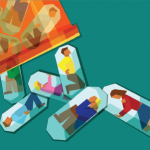Rehabilitation Support
Lisa Sheehy, PT, PhD, research associate at the Bruyere Research Institute, a healthcare and research organization in Ottawa, Canada, that provides rehabilitative services, said a relatively small percentage of people infected with COVID-19 will require physical rehabilitation of some kind. Based mostly on extrapolations from previous outbreaks of SARS and MERS, it’s predicted about half of hospitalized patients and two-thirds of intensive care unit (ICU) patients will need rehabilitation, with 4% requiring in-patient care, she said.
These patients may have such a range of needs that care can become complex. Patients can present with acute respiratory distress syndrome, septic shock, acute kidney injury and polyneuropathy—and these issues can overlap.
“You can see how varied this presentation can be,” Dr. Sheehy said. “Each person could have a whole constellation of symptoms affecting all different systems within the body.”
These patients can require training to increase respiratory muscle strength, slow and progressive aerobic conditioning, stroke rehabilitation, strength and balance work, and many other interventions.
“The most important thing is to do what rehabilitation professionals always do,” she said. “We need to create an individualized treatment plan based on a thorough assessment and consideration of the patient’s rehabilitation goals.”
Providing these services—while each location has its own needs and should consider procedures from a very local point of view—can involve reserving a separate floor, unit or even a separate facility for COVID-19 patients, especially because a patient can test positive even after receiving a negative result.
Depression has increased threefold since the start of the pandemic.
Other measures can include quarantine after arrival from acute care, staying physically distant in gyms if the space is large enough to share with other patients or, possibly, providing therapy in patients’ rooms.
Dr. Sheehy also suggested designating care partners, family or friends to help care for patients and engage with their rehabilitation for logistical and social support.
Create staff teams to help patients through rehabilitation. Continuous training and communication are crucial, because the dynamics, data and protocols for managing COVID-19 patients change so quickly.
“Personnel who work with these patients may have to adapt,” Dr. Sheehy said.
Thomas R. Collins is a freelance writer living in South Florida.
References
- Ettman CK, Abdalla SM, Cohen GH, et al. Prevalence of depression symptoms in U.S. adults before and during the COVID-19 pandemic. JAMA Netw Open. 2020 Sep 1;3(9):e2019686.
- Czeisler ME, Lane RI, Petrosky E, et al. Mental health, substance use and suicidal ideation during the COVID-19 pandemic: United States, June 24–30, 2020. MMWR Morb Mortal Wkly Rep. 2020 Aug 14;69(32):1049–1057.




